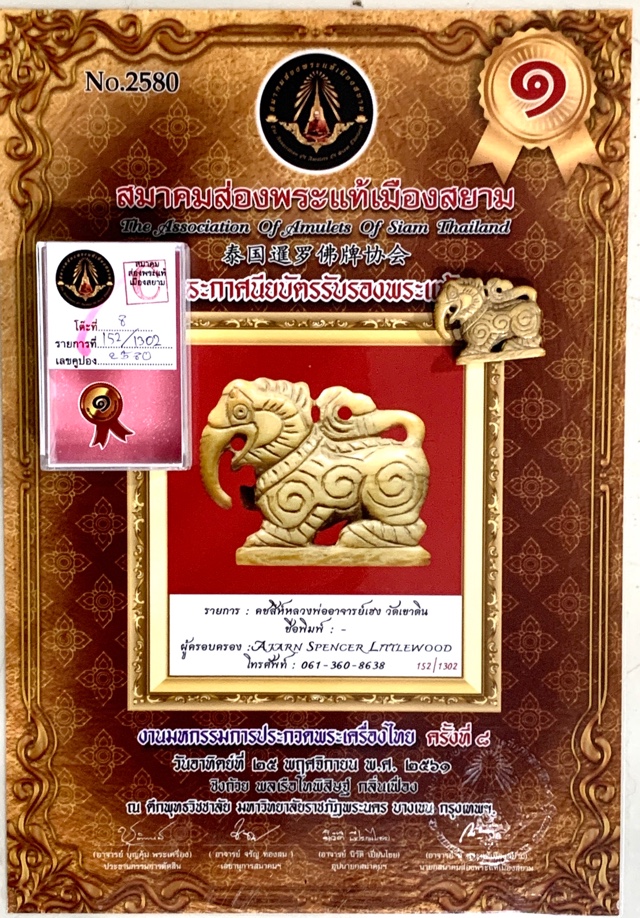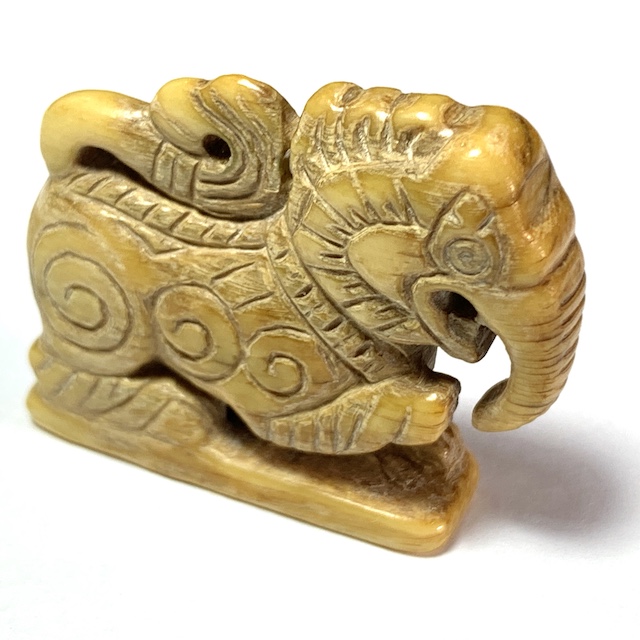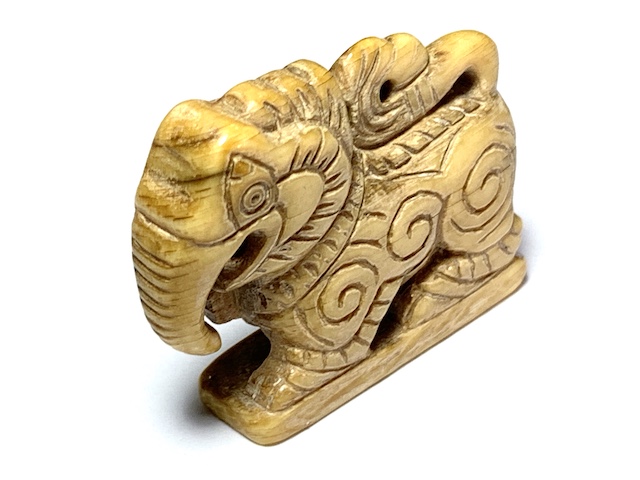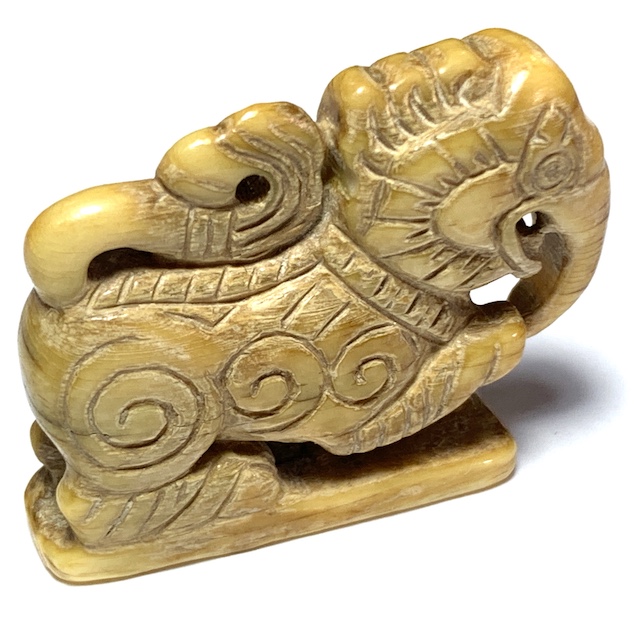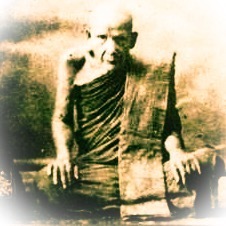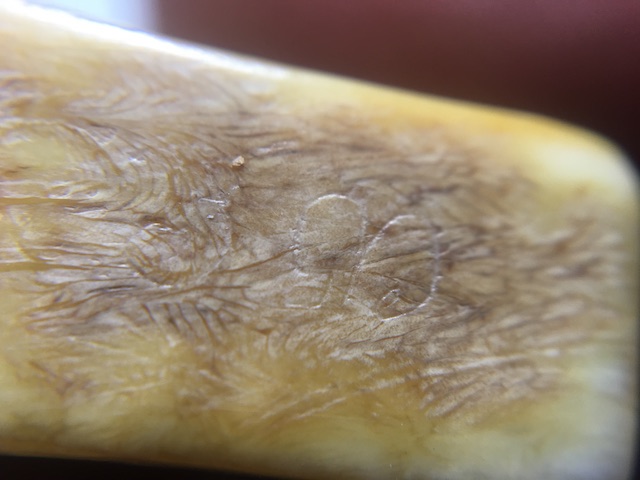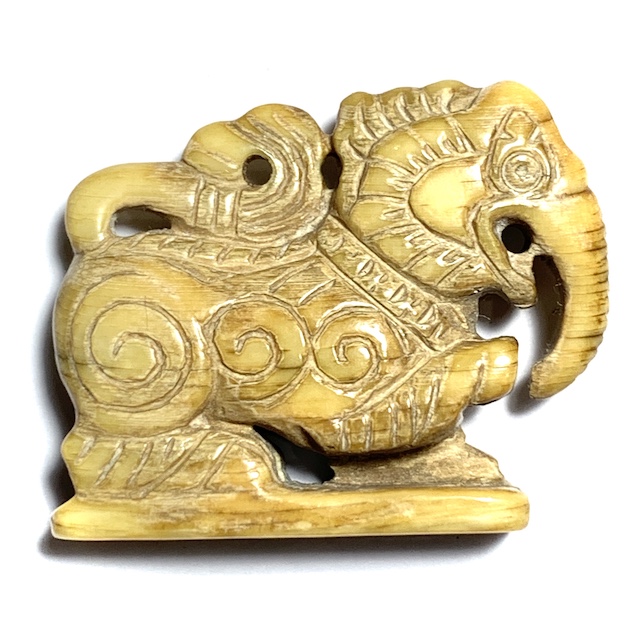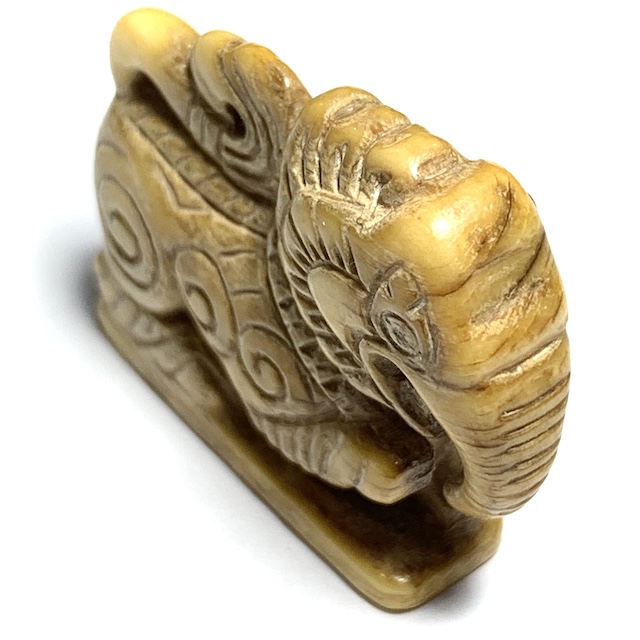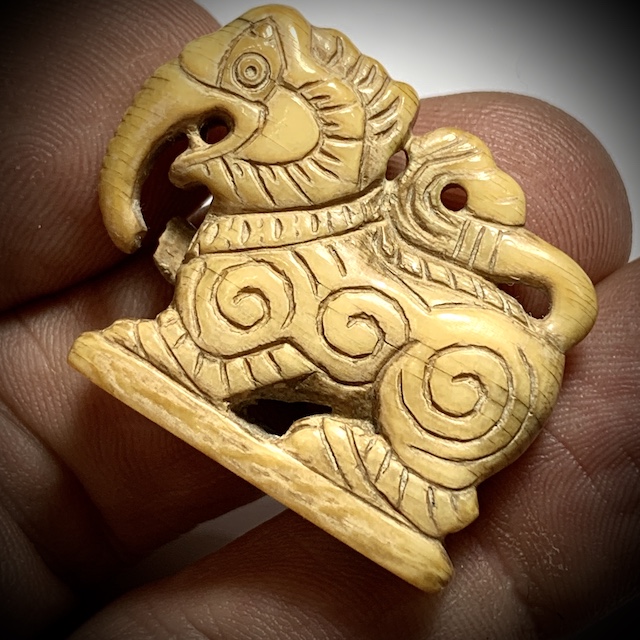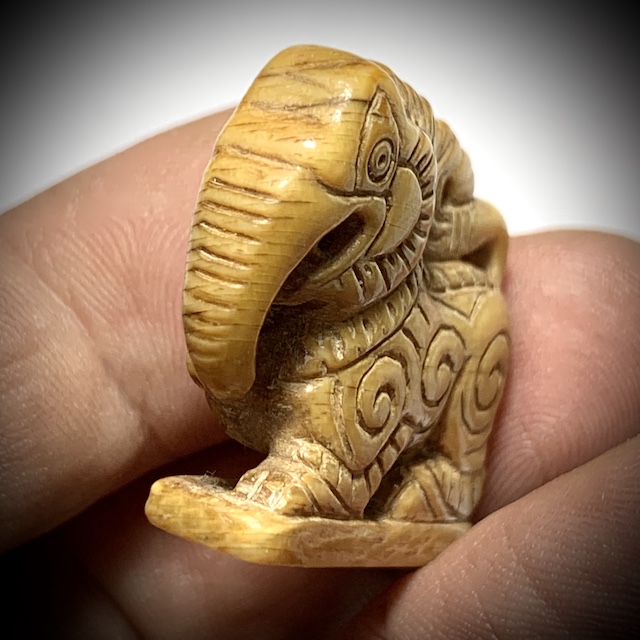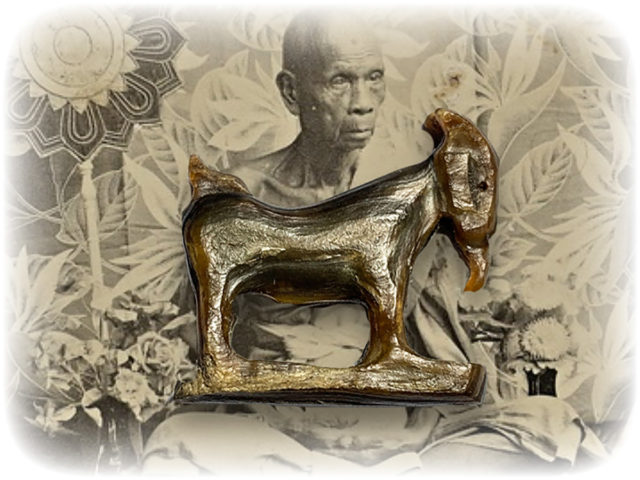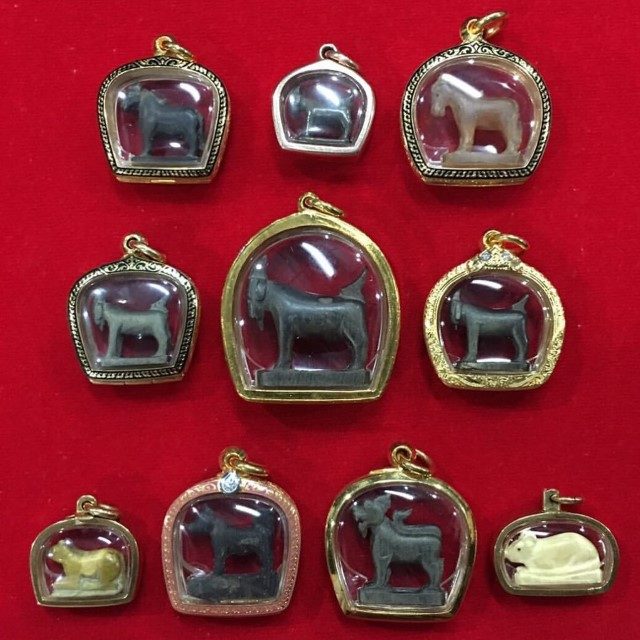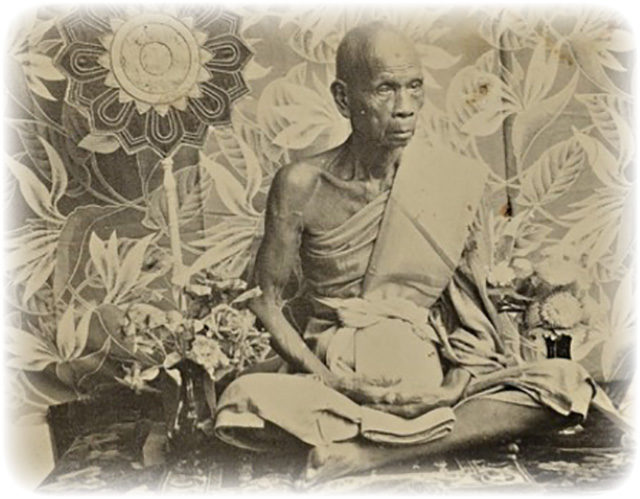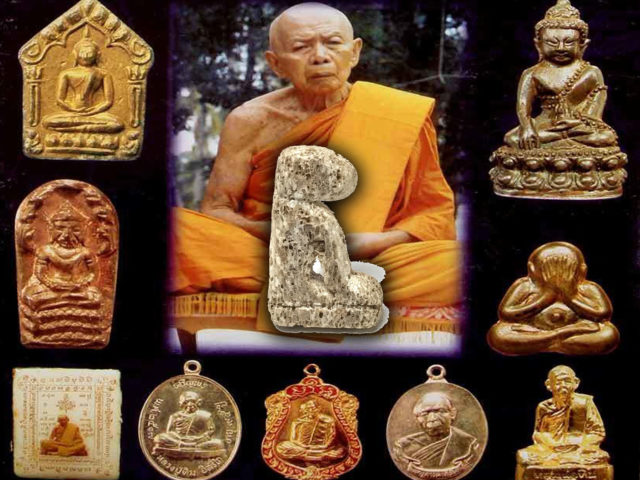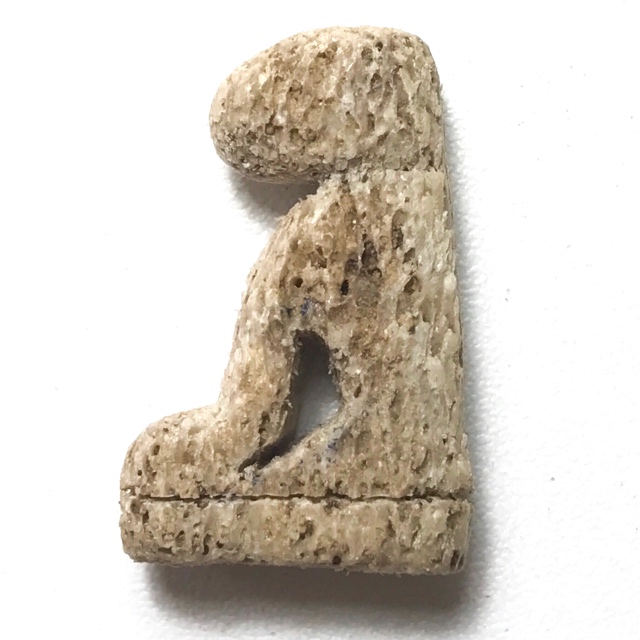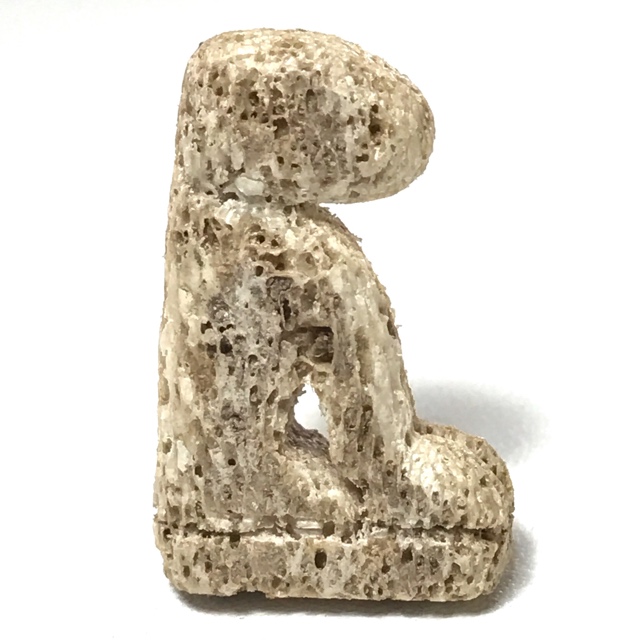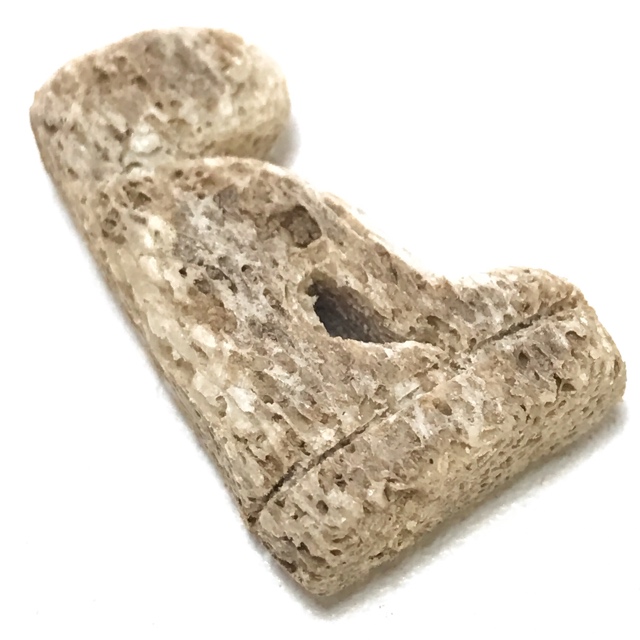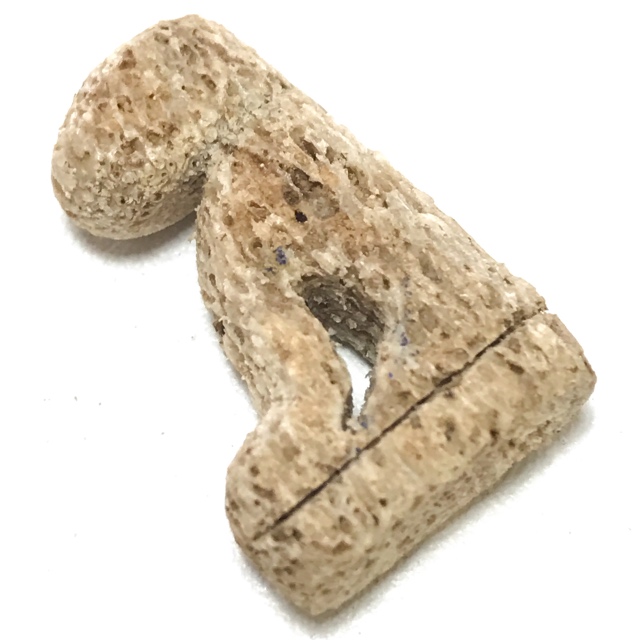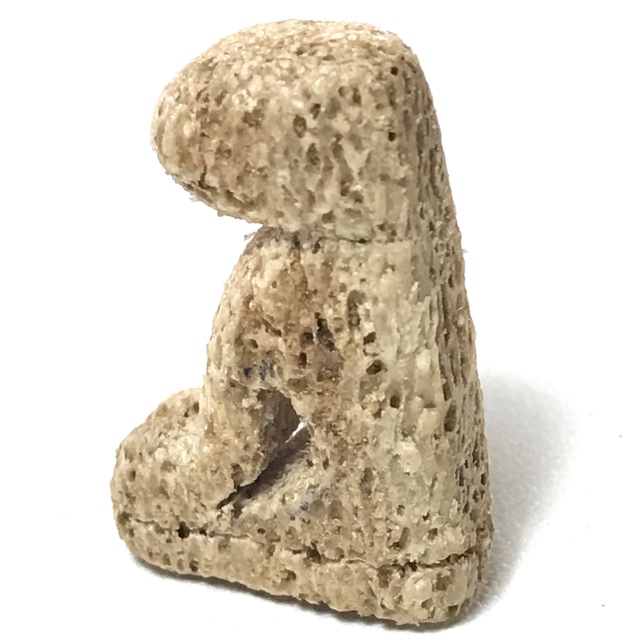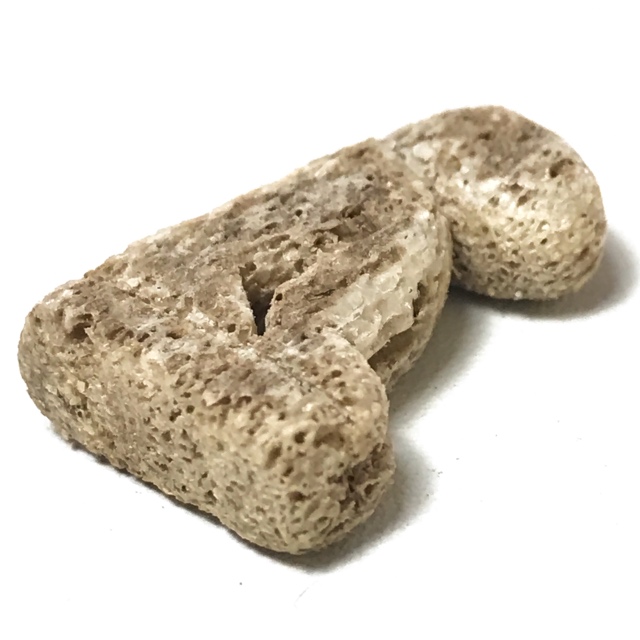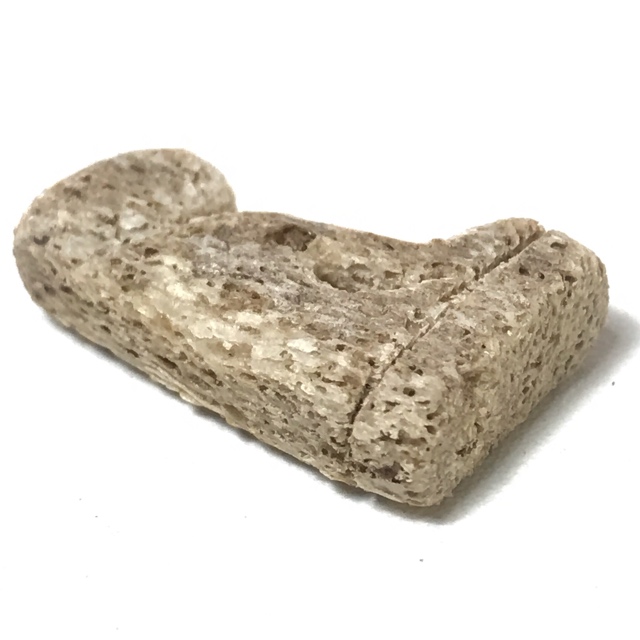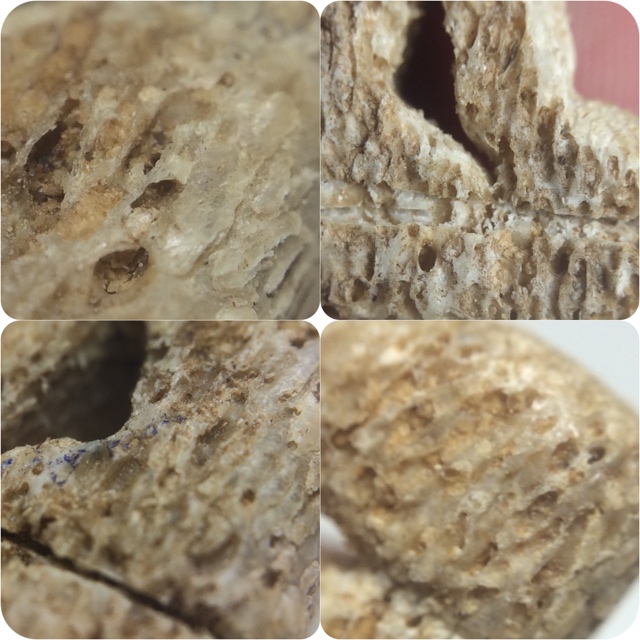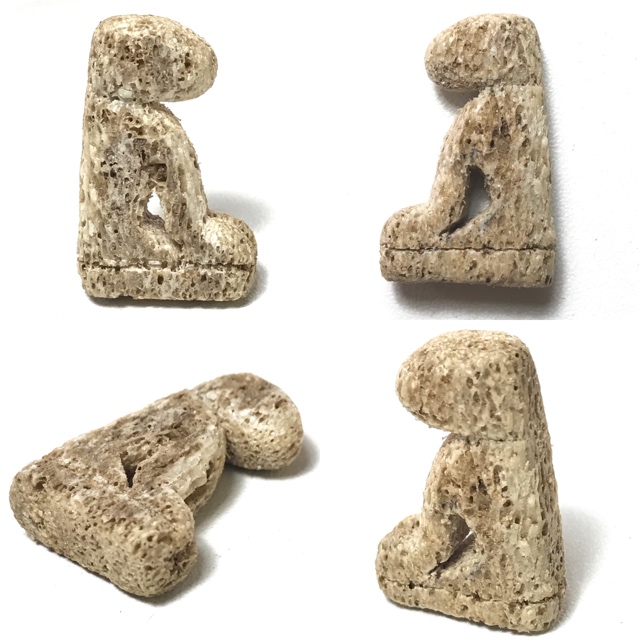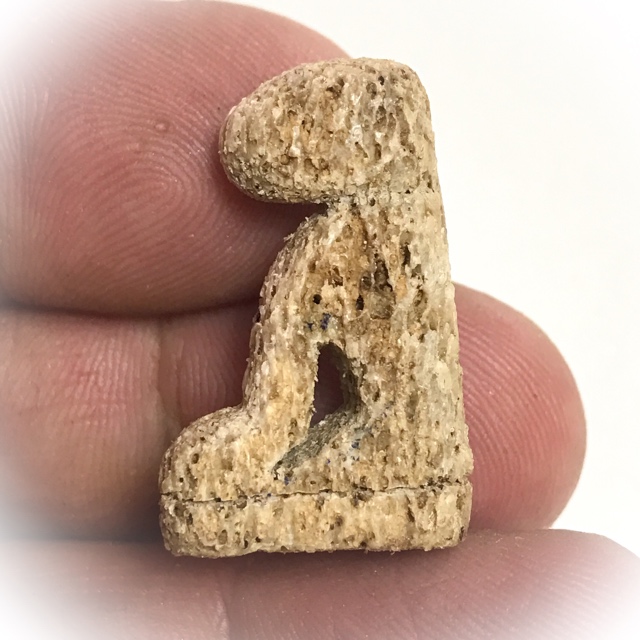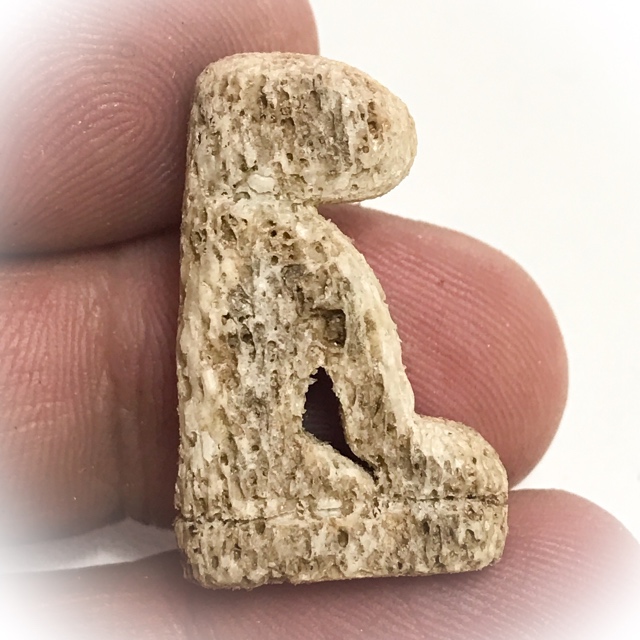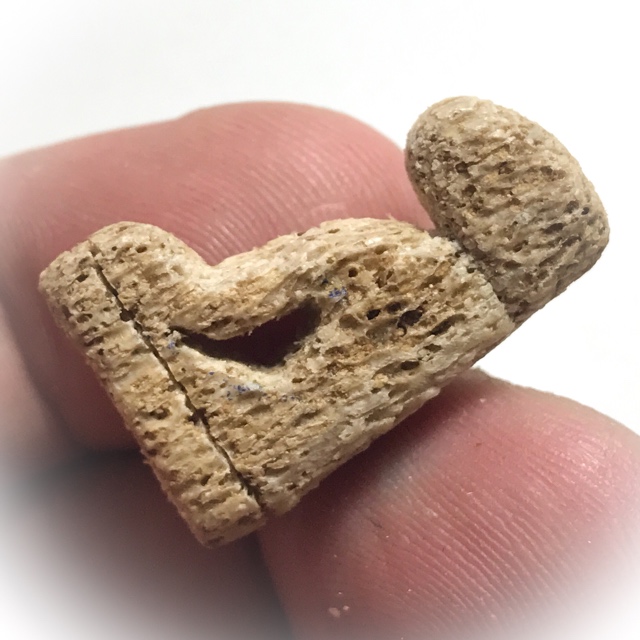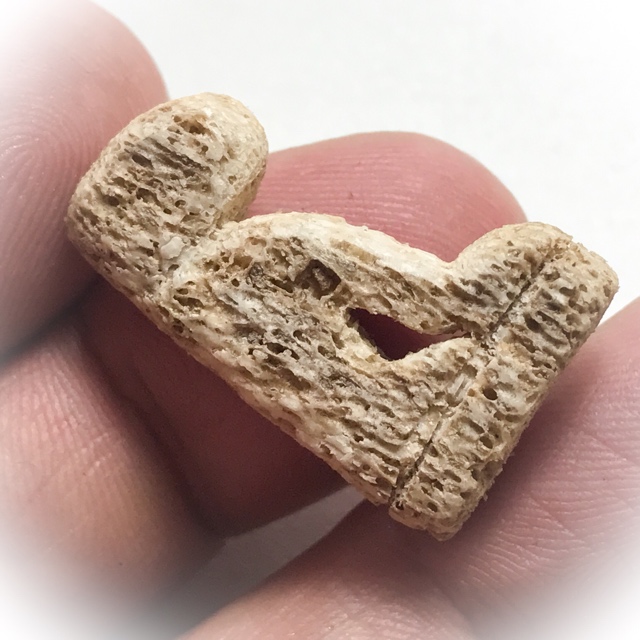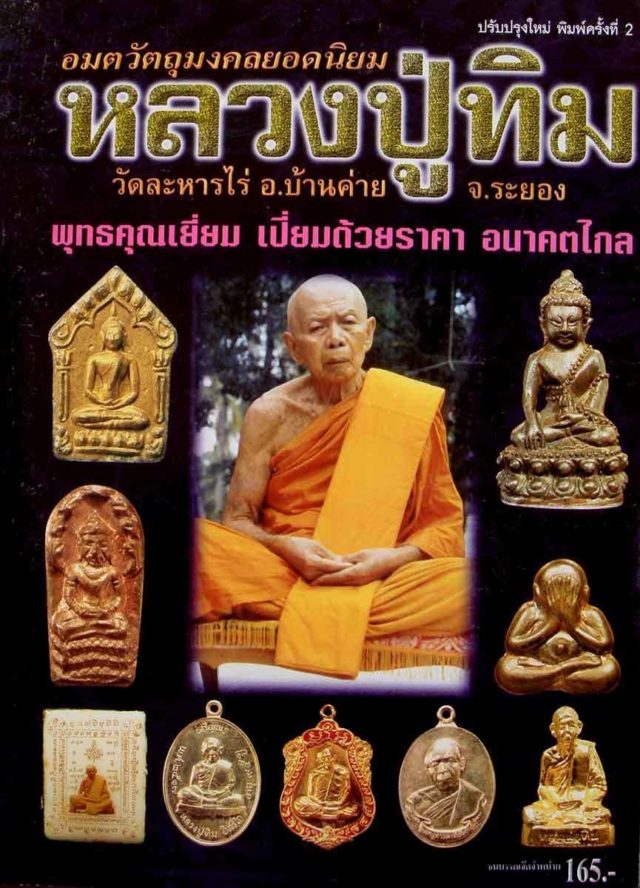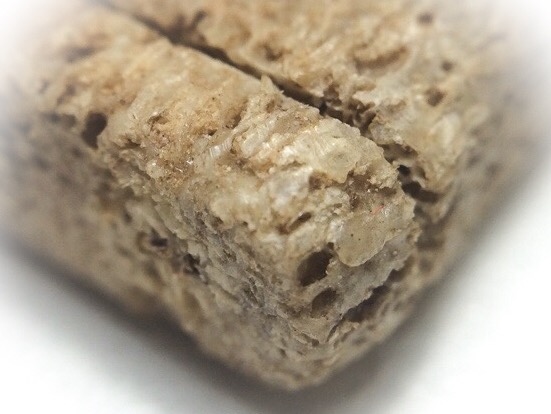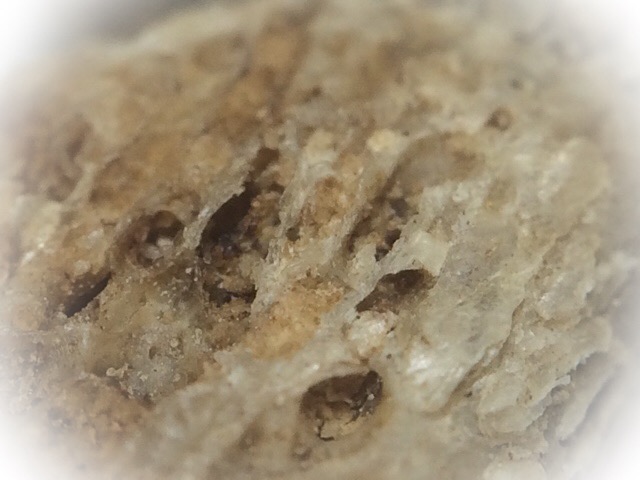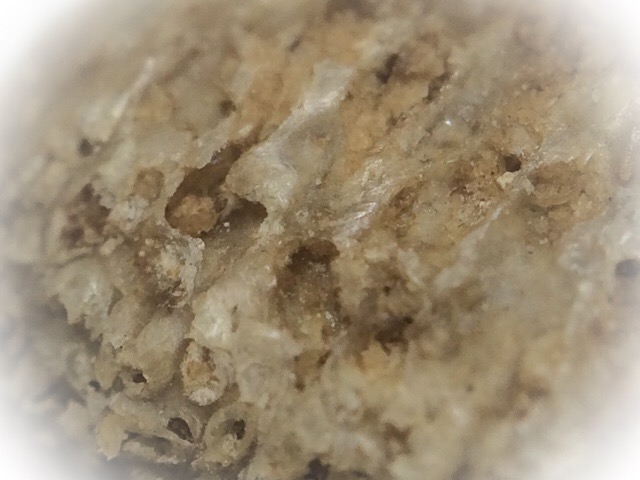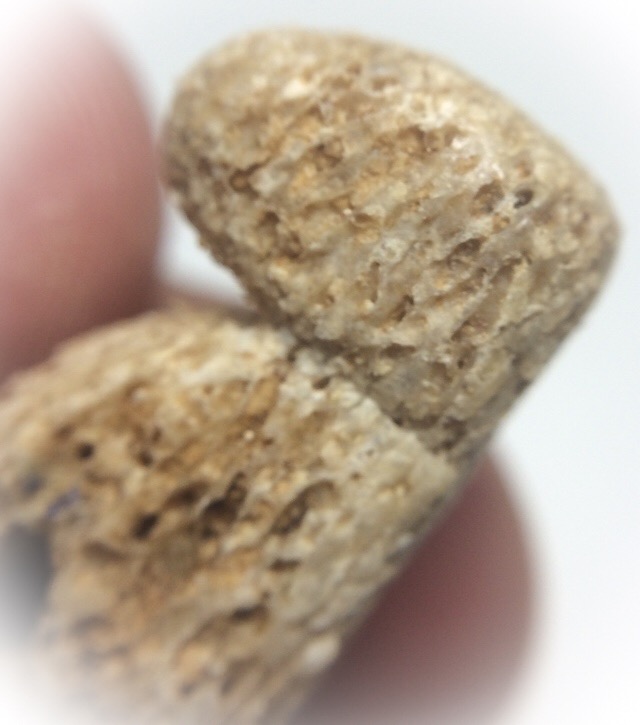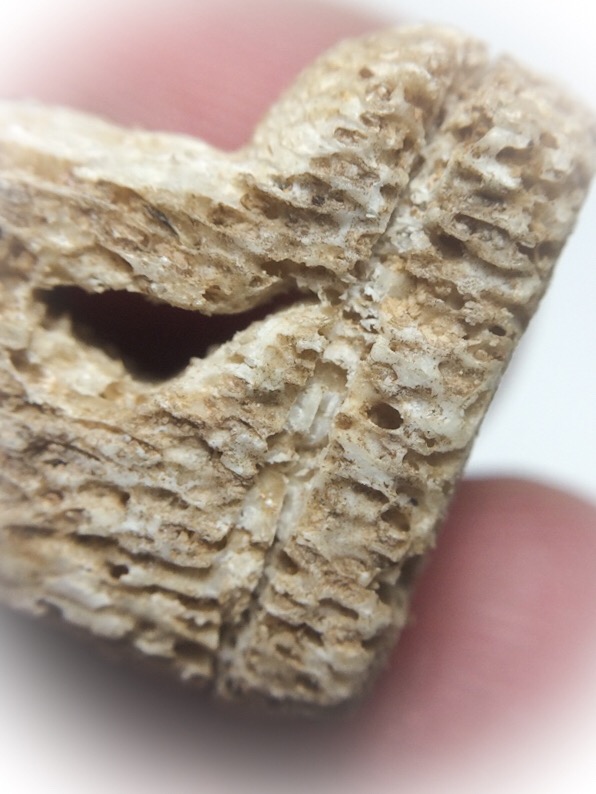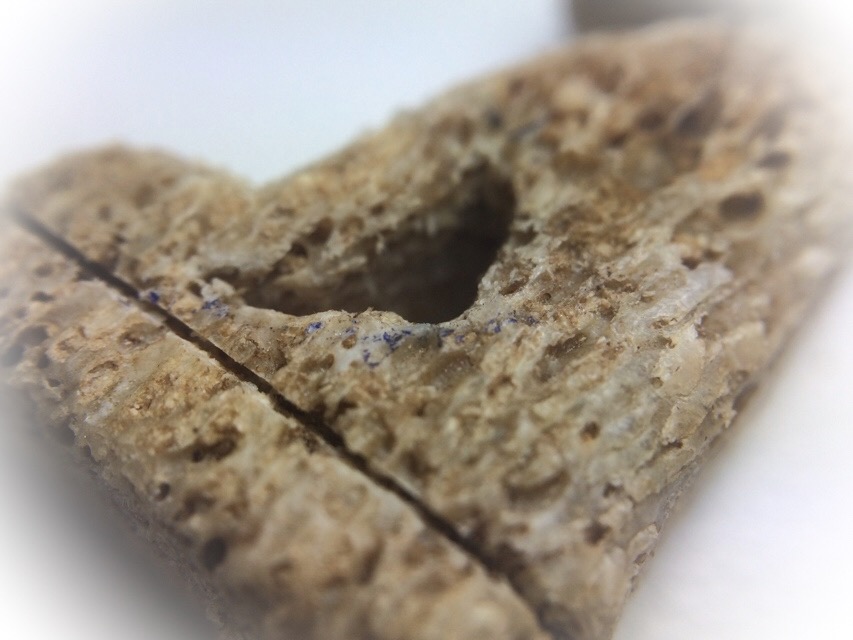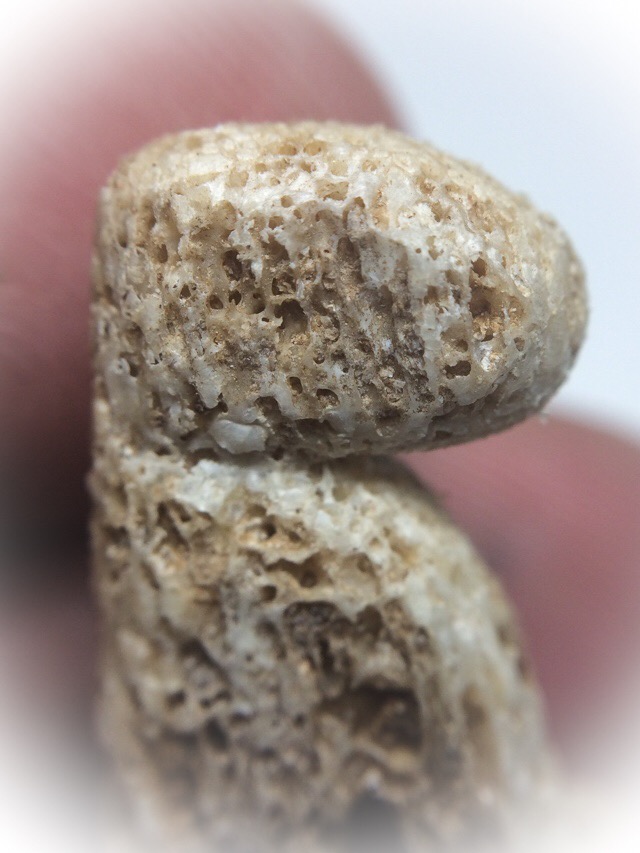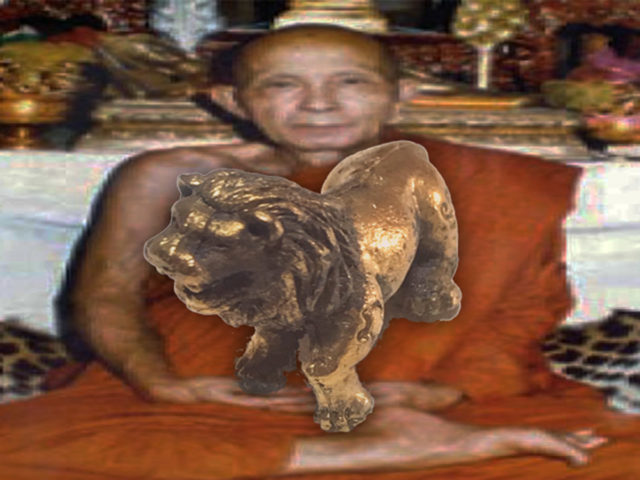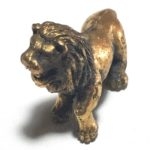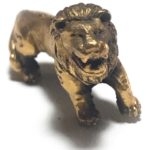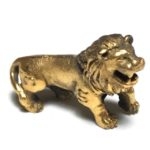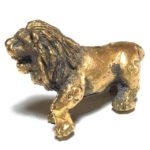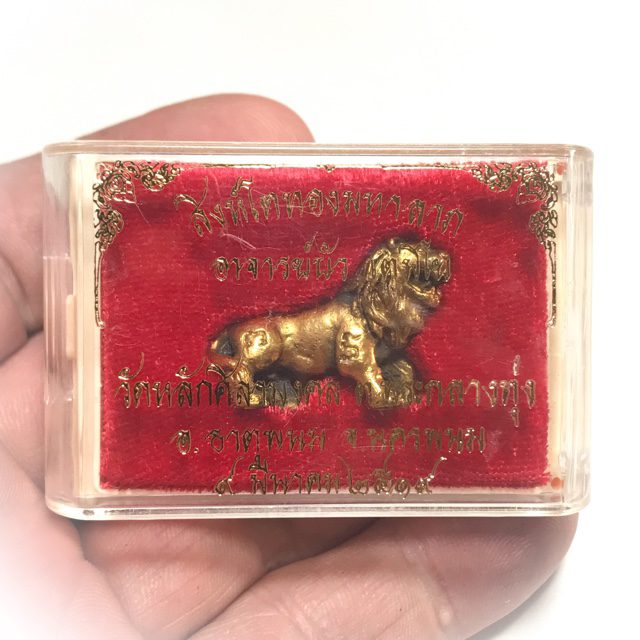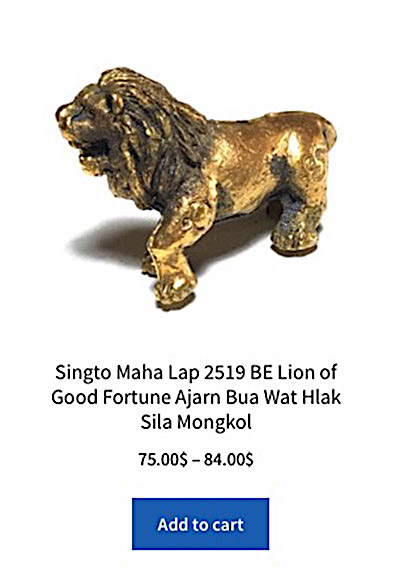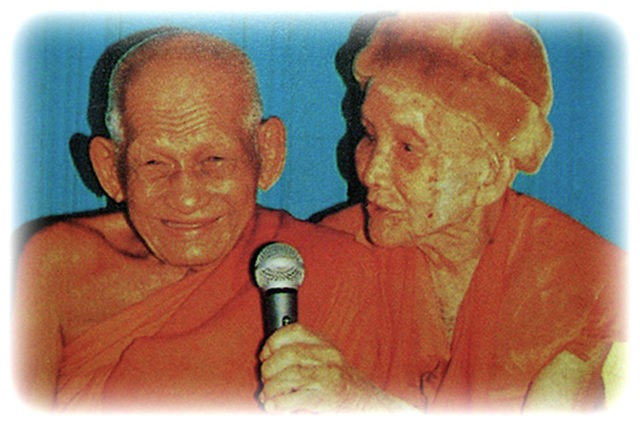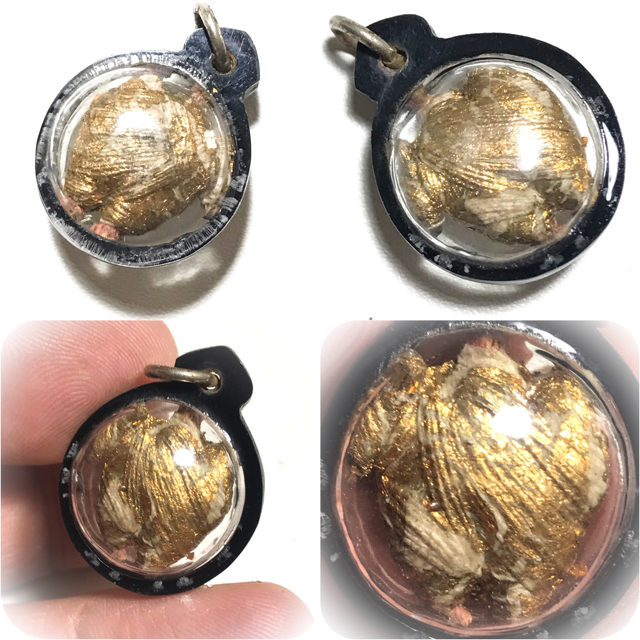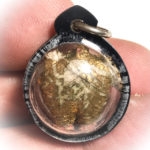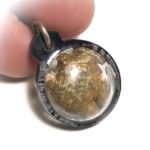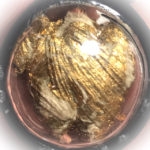One of the top Look Om of all Time; the Immortal Look Om Jet Paya Chang Sarn, of Luang Por Ding (Wat Bang Wua, Chachoengsao), in Nuea Dam Black Prai Powders and Gold Leaf coating, from the ancient times Abbot of of Wat Bang Wua: Luang Por Ding. LP Ding was highly renowned in his day, for his Palad Khik Ling Jab Hlak Vanora Monkey animist charms, and for his Sacred Powder Look Om wishing balls, made from his legendary Pong Ya Jet Paya Chang Sarn substance.
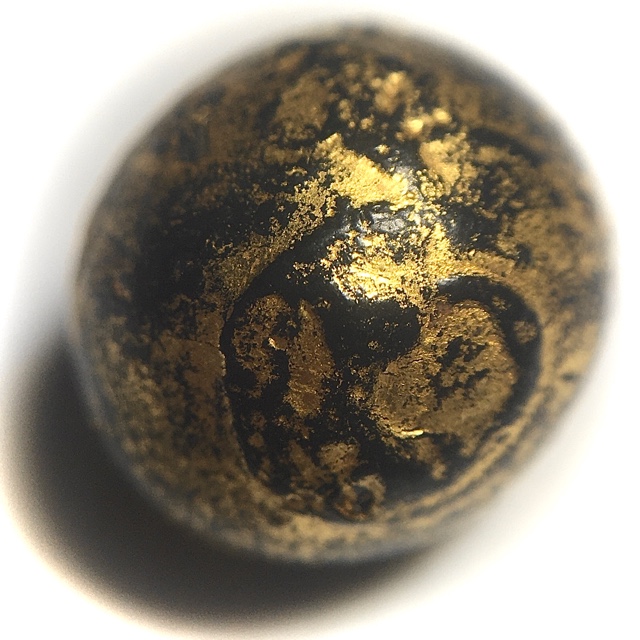
The Sacred Jet Paya Chang Sarn Muan Sarn Sacred Powders were made from the Klai Pra Chedi (pieces of the ancient Chedi Stupas of 7 Temples), Klai Sema (ground up pieces of temple boundary stone) of 7 Temples, Pieces of stone from 7 Uposatha Shrinerooms, mixed with Pong Ittijae, & Pong Maharaj Yantra Powders.These substances were ground up in a mortar with incantations and molded into Look Om Sacred Powder Balls, of small size
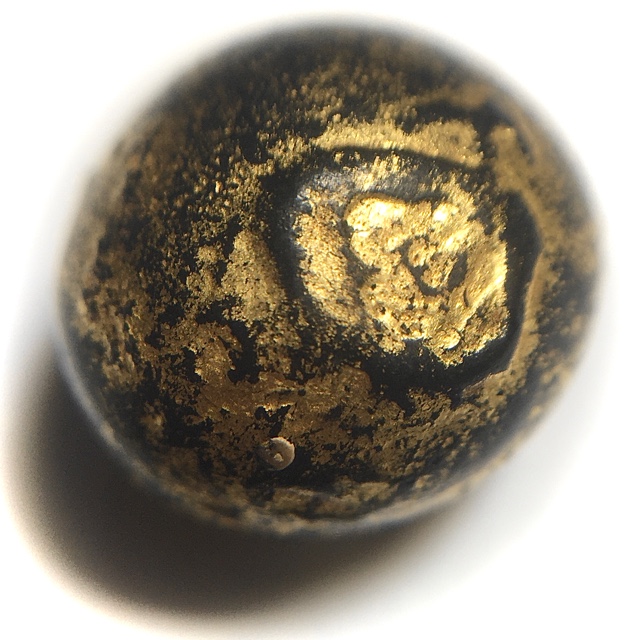
The Look Om Jet Paya Chang Sarn of Luang Por Ding is noticeably dense and hard, for Luang Por Ding would let them harden first, and would mix the powders with Rak Herbal Lacquer resins. Some Look Om would be covered in gold leaf, and some would be left bare black colour.Luang Por Ding would keep the Muan Sarn Sacred Powders and the Look Om he had made for a long time in his Kuti Hut to empower them, and would only release them when he was completely certain of their power.
Luang Por Ding would release the Look Om to his devotees during temple ceremonies, and on his birthday celebrations.The Look Om Jet Paya Chang Sarn is spoken of in the Legend of the Great ‘Suea Khaw’ Invincible Gangster, who was a Looksit of Luang Por Ding. Suea Khaw maintained that he survived throughout the years of his gunmanship because of the Look Om Paya Jet Chang Sarn, which stopped many bullets from piercing his skin and killing him over the years. It is said to have given Suea Khaw the strength and imposing aura of invincibility, to overcome all his enemies.
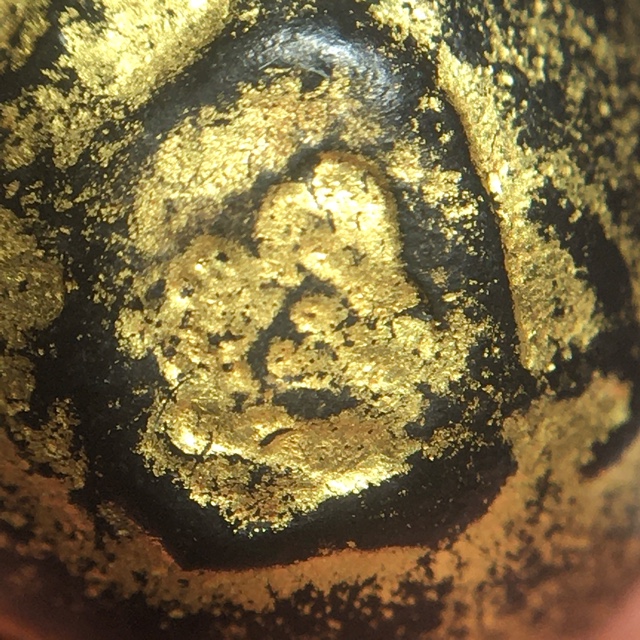
The Look Om gained the name of ‘Jet Paya Chang Sarn’ because of its legendary power to increase the stamina and strength of the devotee over his or her adversaries. It is said that the wearer of the Look Om Jet Paya Chang Sarn is endowed with the strength of the Paya Chang Sarn Battle Elephant. The Look Om is said to both Protect against all Dangers, and Endow the wearer with Commanding Power and Strength. Suea Khaw was a Gangster who was reputed to have defeated and killed over 100 of his competitors, and who had a reputation for his bravery and strength. Because his sole chosen amulet of protection and power was the Look Om Jet Paya Chang sarn, and the fact that nobody cold defeat him or kill him, was the reason for Luang Por Ding’s Look Om Jet Paya Chang Sarn becoming so Legendary.
But one day, Luang Por Ding told Suea Khaw that he was too violent and that if he did not give up being a gangster, then he would surely encounter a violent and premature death. Suea Khaw had become very overconfident because no knives were able to penetrate his skin, and guns would not fire when aimed at him. Because of the invincibility which Suea Khaw had been enjoying, Suea Khaw did not listen to Luang Por Ding’s warnings.
One day the Police Force special missions unit came to Wat Bang Wua to ask Luang Por Ding if it was true that Suea Khaw possessed ‘Hnang Hniaw (‘sticky skin’. a term meaning a person with Kong Grapan Chadtri Magic). Luang Por Ding admitted that it was true that Suea Khaw possessed Protective Magic, and that he was not able to be killed with knives or guns. But Luang Por Ding added that Suea Khaw would fall prey to his own Karma without need of guns or knives, because he refused to listen and change his ways. Luang Por Ding added “I cannot tell you though, by which way the gangster Suea Khaw can be killed, for it would break my Precepts”.
But at this moment, one of the Samanera Novice Monks was listening and butted in to say to the Police “If you want to kill Suea Khaw, you have to use a bullet that has the head of the bullet cast from metal taken from the blade of a Mitmor spirit knife from Luang Por Soke (Wat Pak Klong)”.
Luang Por Soke was a colleague of Luang Por Ding and holder of the same Lineage Wicha, and would inscribe the Wicha of Luang Por Ding onto the Blades of his Mitmor. Some time later the Police caught Suea Khaw and he was sentenced to death, and was executed by Government Executioner, using Bullets cast from the blade of a Mitmor of Luang Por Soke.
Luang Por Ding was renowned for his expertise in the Wicha Hanuman and other Vanora Monkey Deities. He personally blessed numerous hand-carved talismans, with the most skillfully crafted ones being the most sought after. Luang Por Ding is also connected to the Cow symbol, stemming from the name of his temple, Wat Bang Wua. His Look Om Jet Paya Chang Sarn is highly regarded and is considered a powerful amulet for Kong Grapan Chadtri Maha Ud Klaew Klaad.
Luang Por Ding, was a Great Master of the Wicha Hanuman, and all Vanora Monkey Deities, for which he was extremely famous. He blessed many inimitable hand carved talismanic amulets (Krueang Rang), made from artisans of varied levels of skill, with of course the most masterfully carved attaining the highest level of preference. His Look Om Jet Paya Chang Sarn, by general consensus, to be one of the top Look Om of all Time and is also a high ranking amulet in the annals for Kong Grapan Chadtri Maha Ud Klaew Klaad Power.
The Look Om Jet Paya Chang Sarn amulet of Luang Por Ding, released in the Thai Buddhist Era of 2480 BE, was made using a traditional method of infusing sacred powder, which is believed to possess spiritual and protective properties.
The powder was collected from rare and magical forest herbs, earths, and sacred materials over decades of Tudong forest wandering, along with the ubiquitous pieces of the ancient Chedi Stupas of 7 Temples, Klai Sema,stone from 7 Uposatha Shrinerooms, mixed with Pong Ittijae, & Pong Maharaj Yantra Powders and meticulously prepared over time, performing incantations constantly throughout, often through a long and intensive process, and is infused with prayers and blessings. The resulting amulet, known as a Luang Por Ding Thai Sacred Powder Wishing Ball, is a powerful and meaningful symbol of faith and spirituality for many Buddhists around the world.
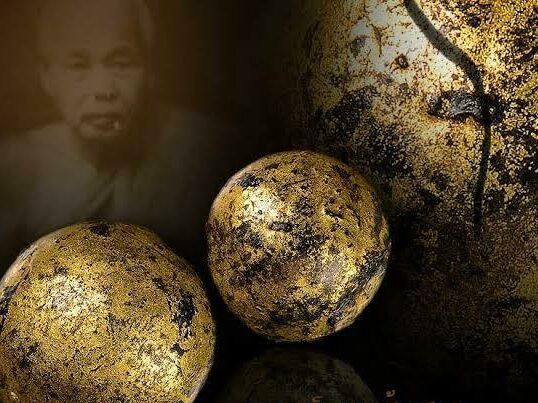
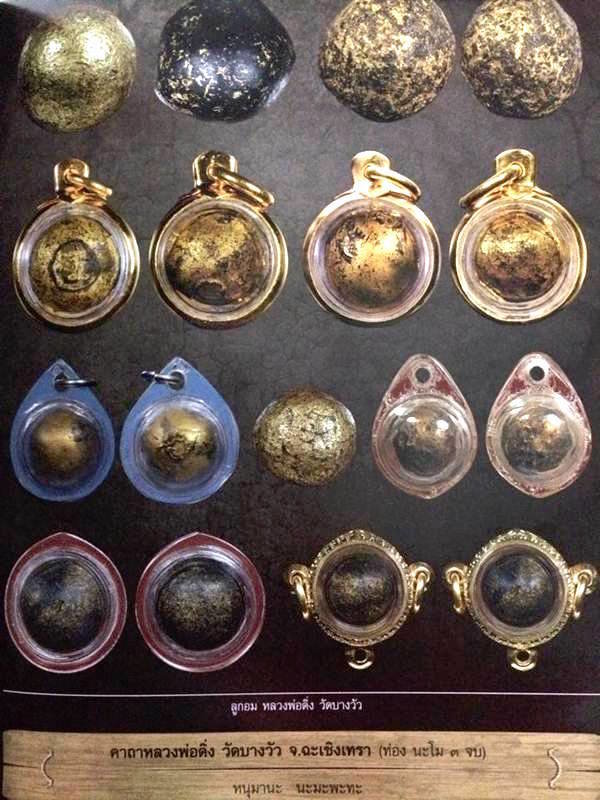
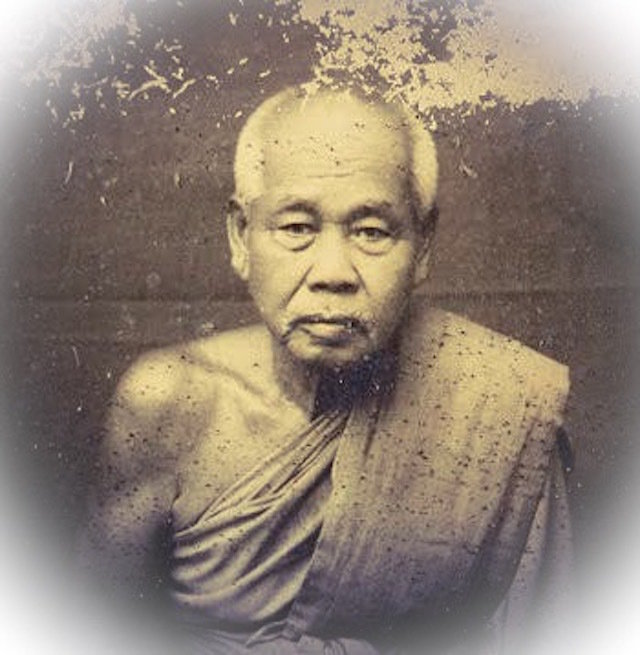
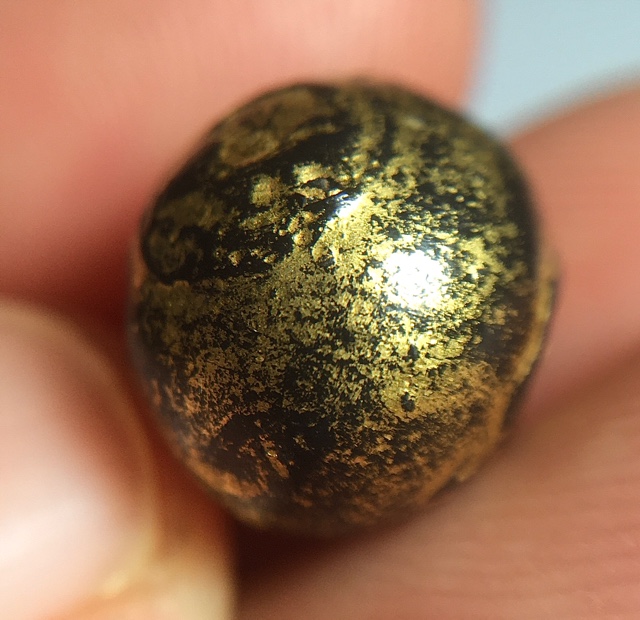
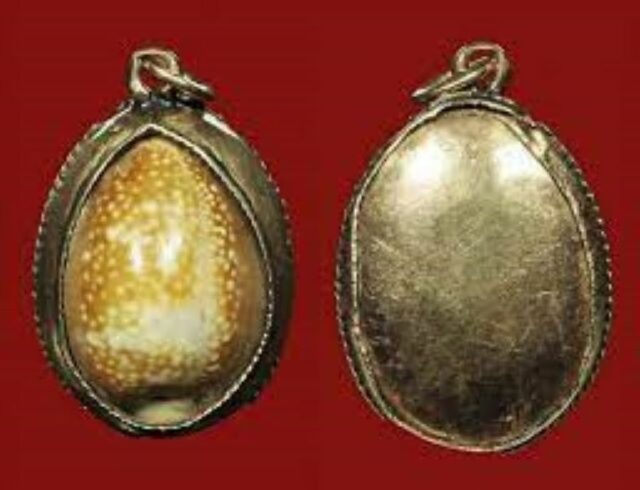
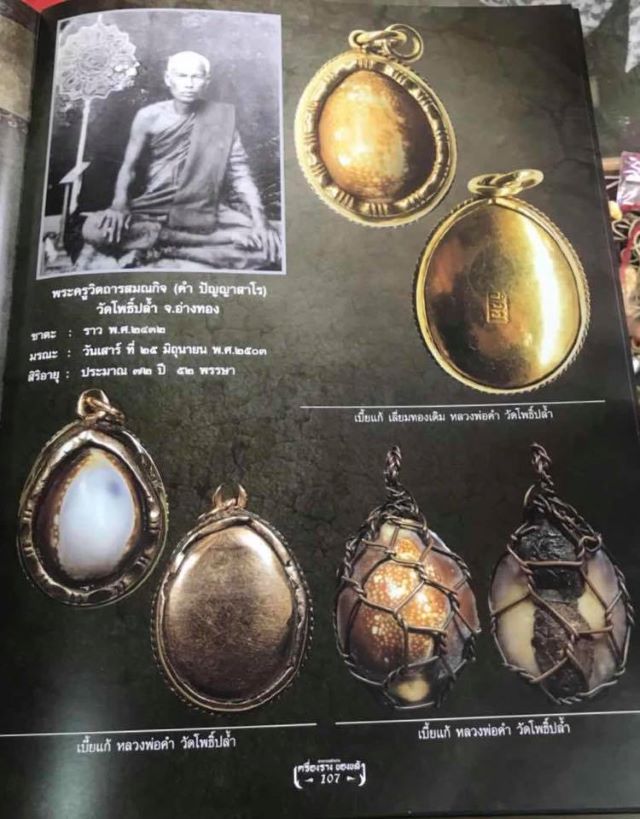
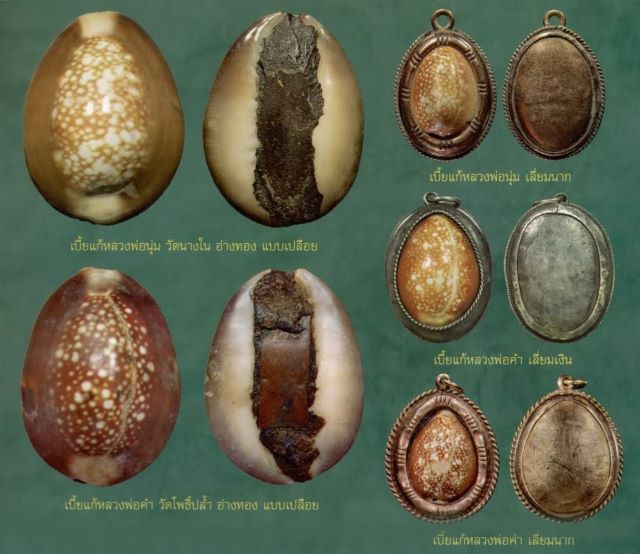
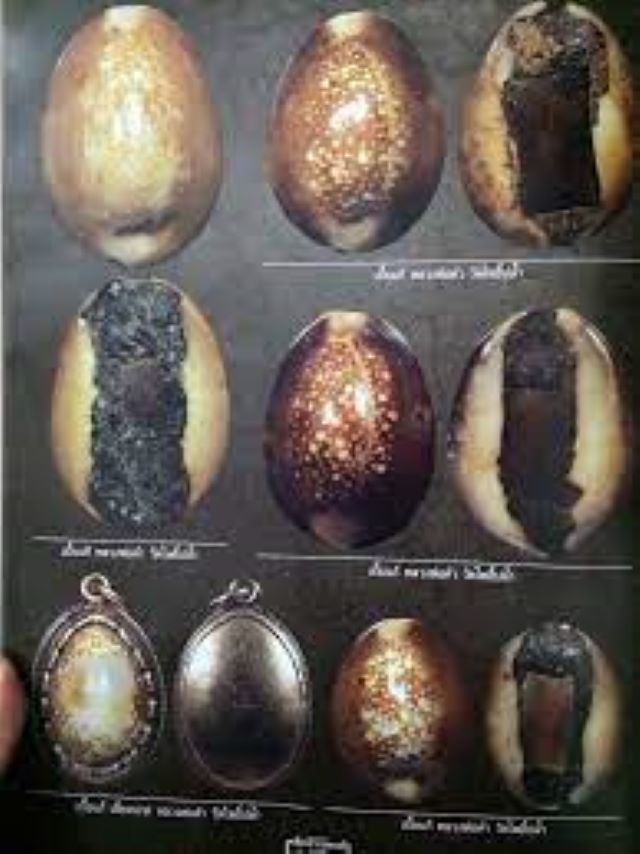
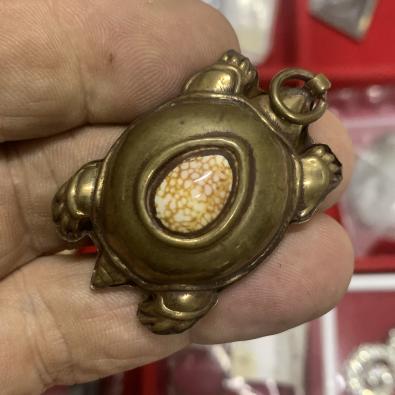
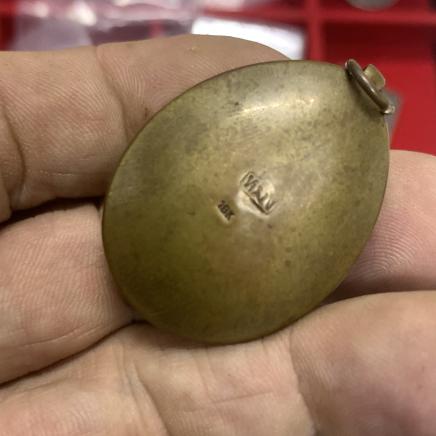
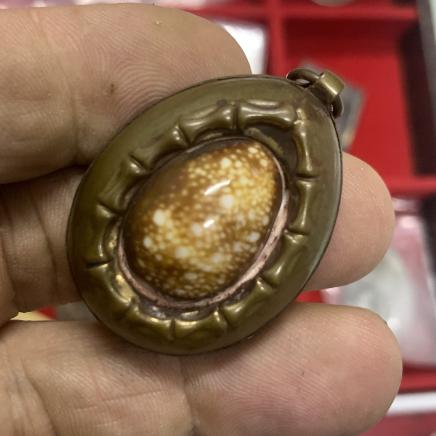
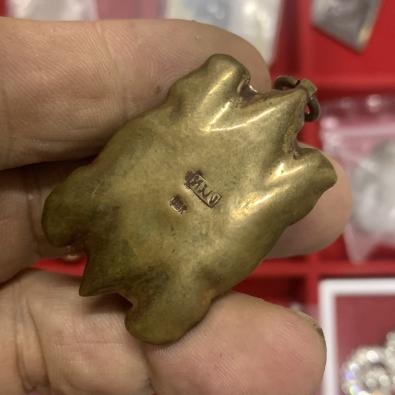
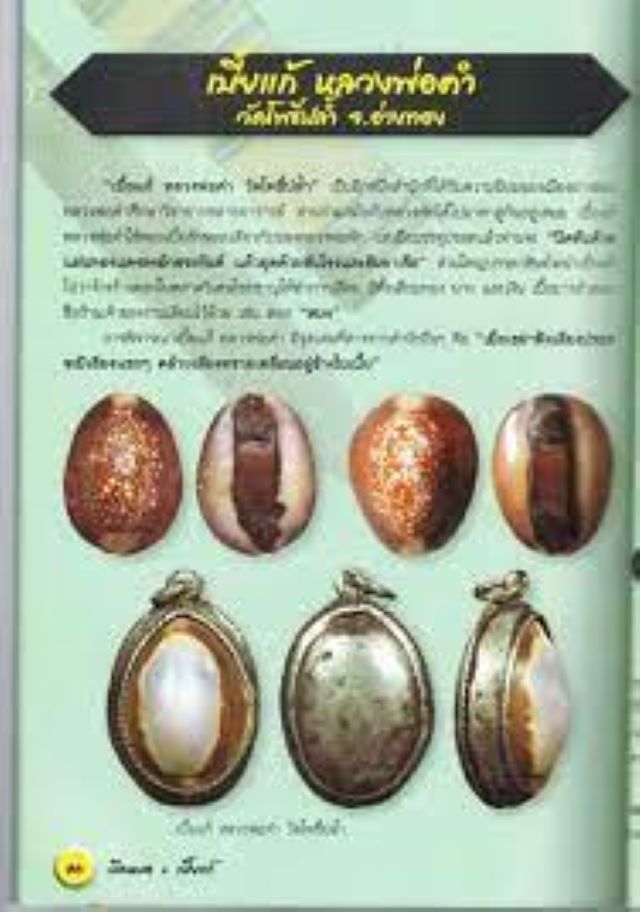
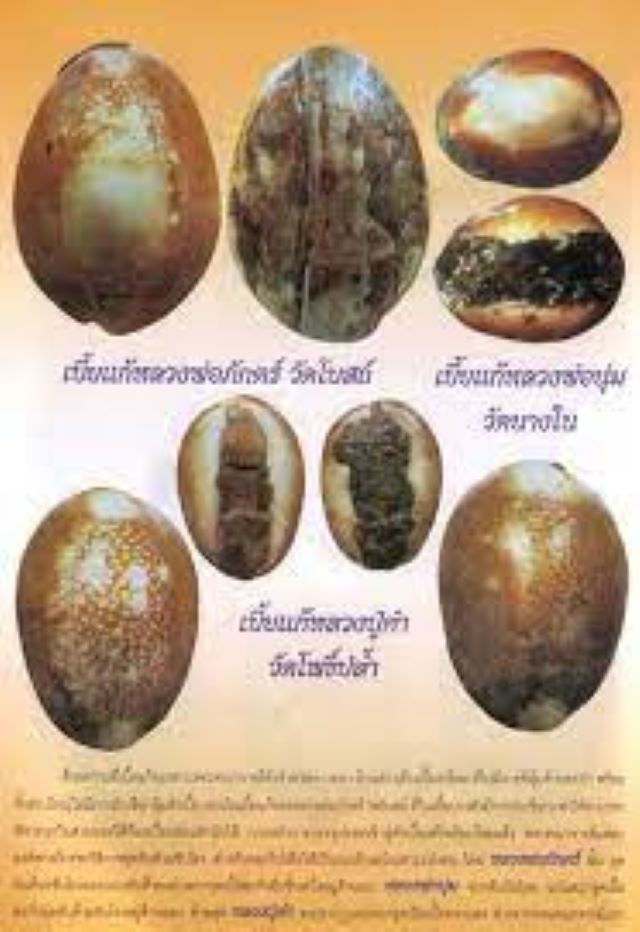
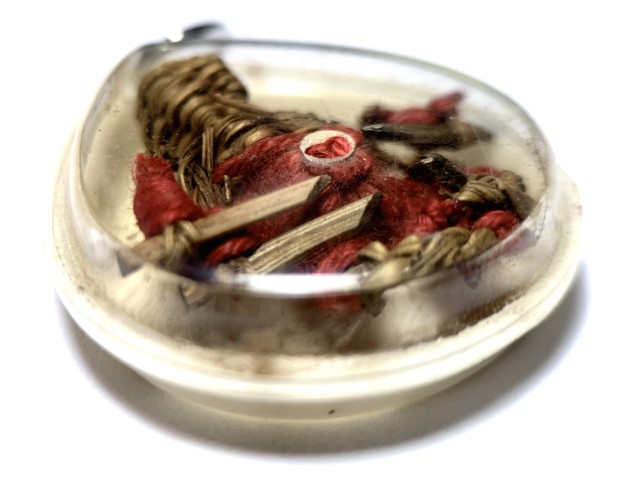
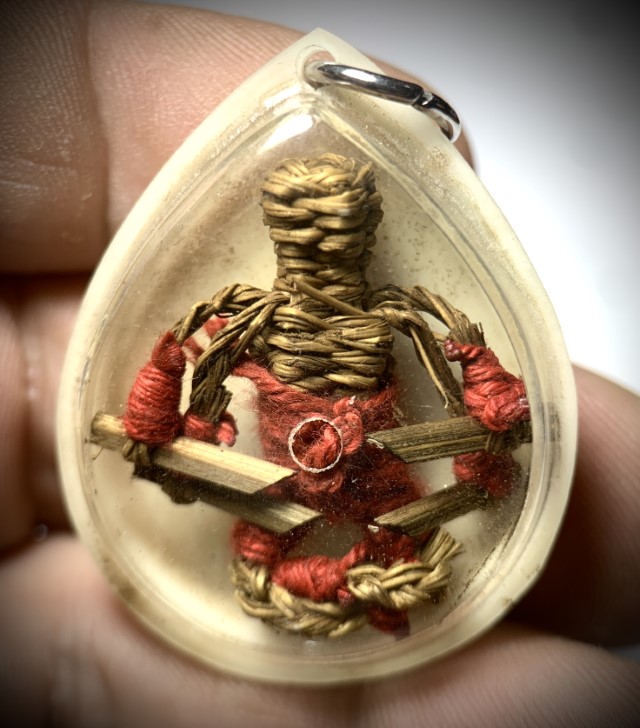
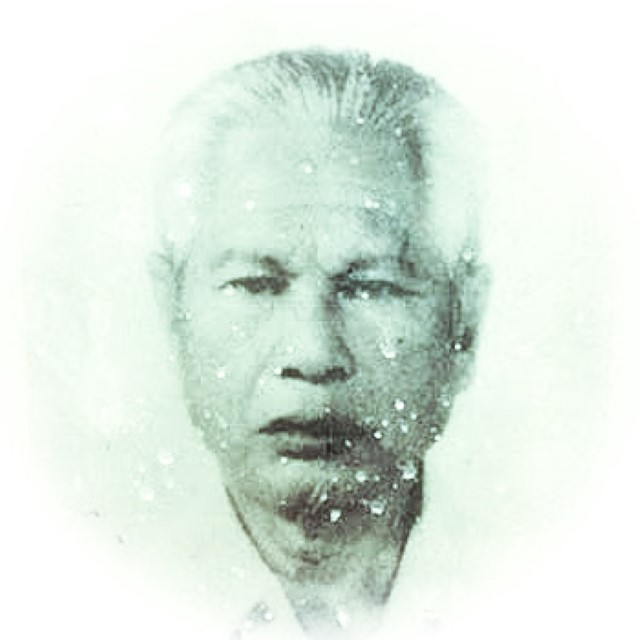
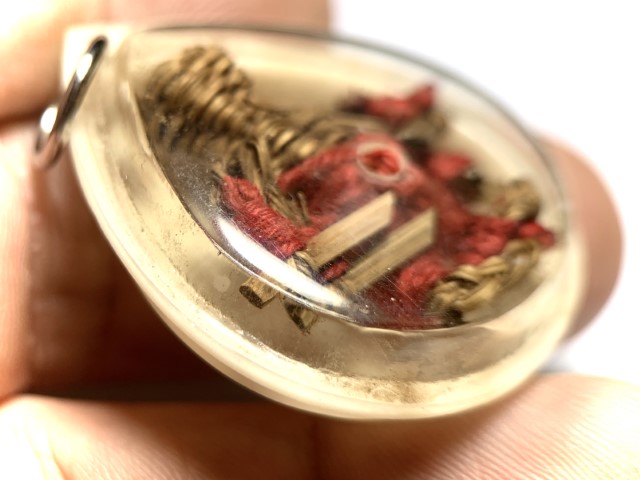
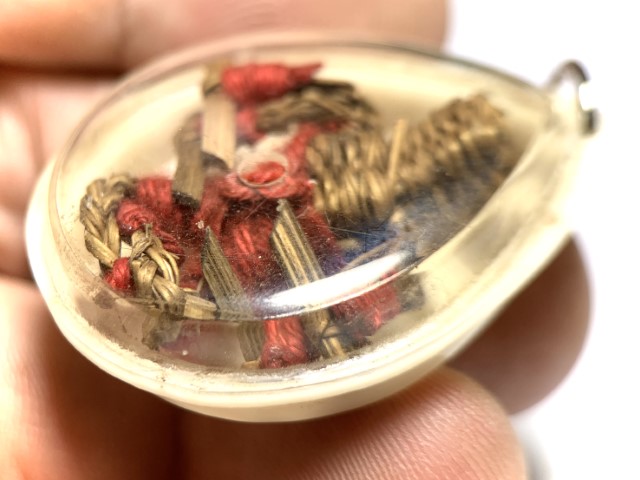
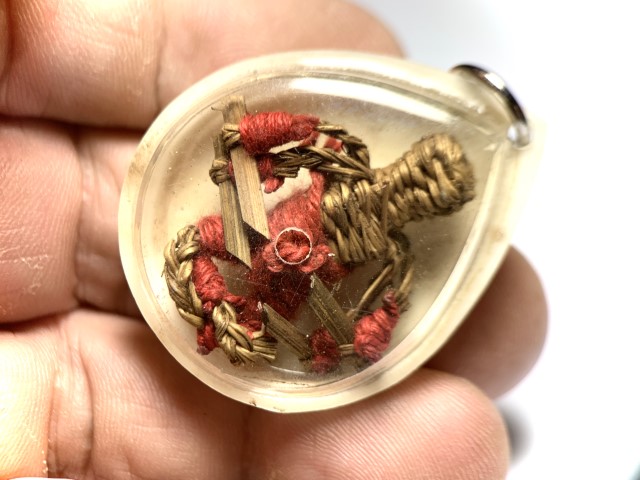
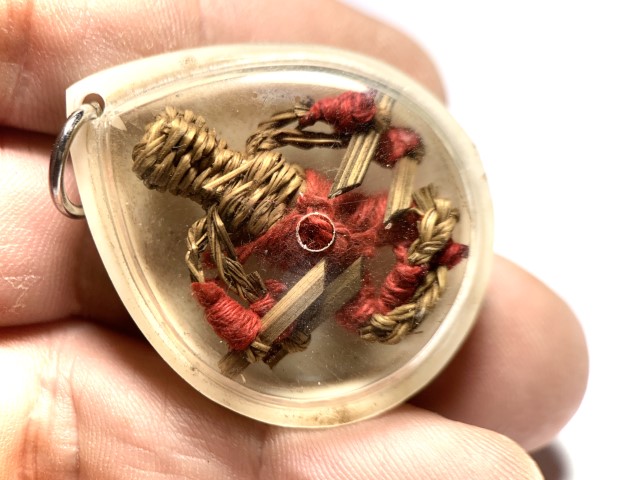

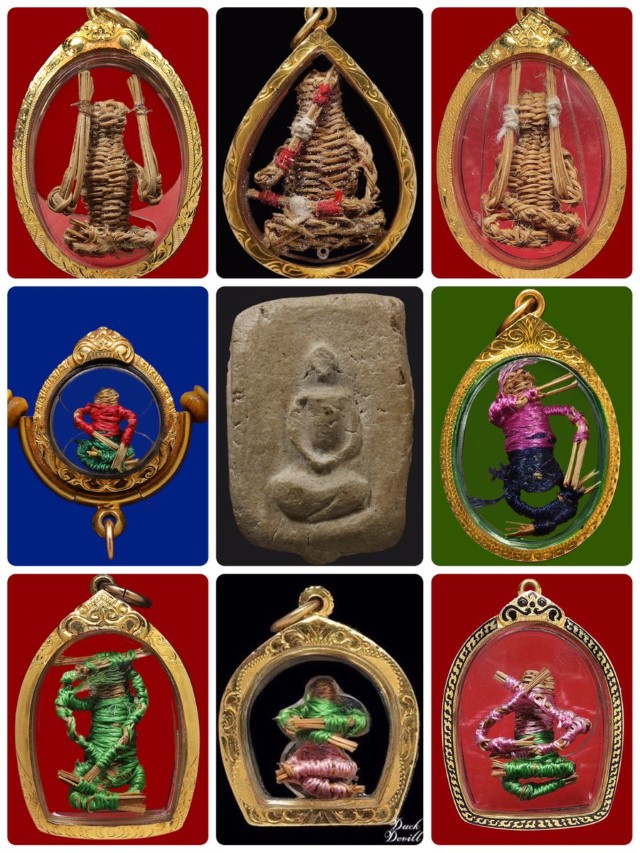
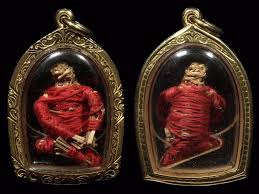
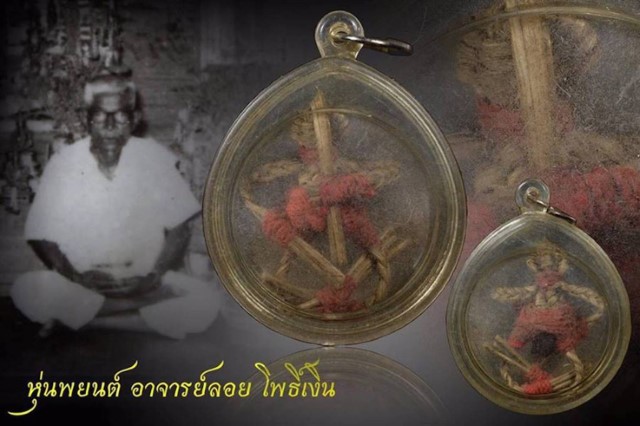
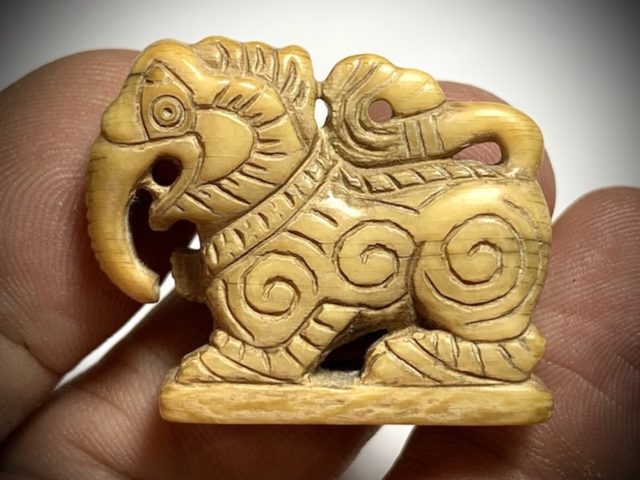
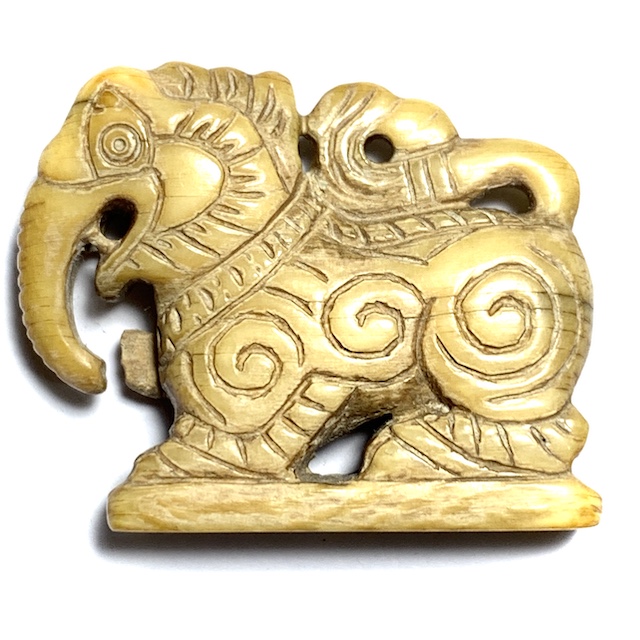
 Free EMS Shipping is Included with this item. The Kochasri Lion itself, especially when carved from Ivory, is naturally imbued with the Sorcerous Powers of Maha Amnaj (commanding power and influence), Serm Yos Status Increase for positions of command, and opportunities of promotion, and Metta Mahaniyom Mercy Charm to lull your Subjects and Charm them into Obedience. Maha Pokasap treasure Accumulation and Cornucopia of Requisites is also Imbued.
Free EMS Shipping is Included with this item. The Kochasri Lion itself, especially when carved from Ivory, is naturally imbued with the Sorcerous Powers of Maha Amnaj (commanding power and influence), Serm Yos Status Increase for positions of command, and opportunities of promotion, and Metta Mahaniyom Mercy Charm to lull your Subjects and Charm them into Obedience. Maha Pokasap treasure Accumulation and Cornucopia of Requisites is also Imbued.